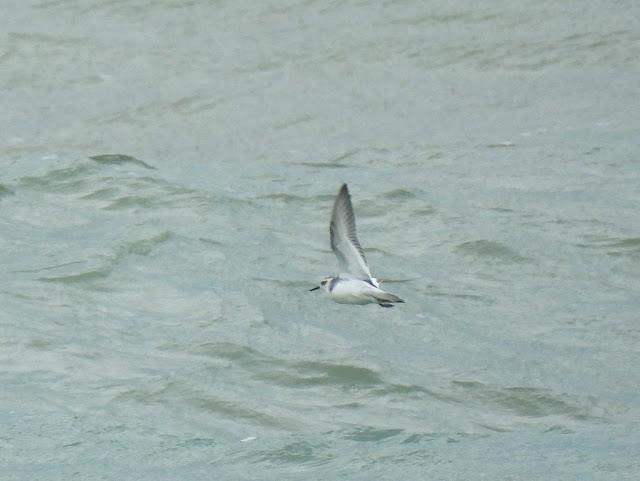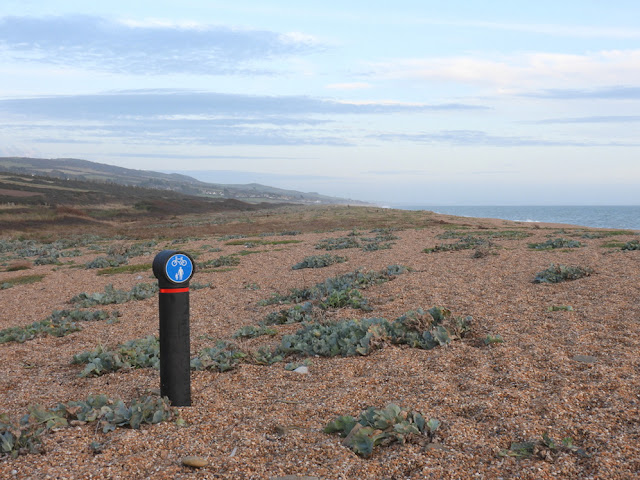Since Monday's visit to Cogden I've managed three more. They have
gone...er...rather well.
Tuesday
Only four species made it into note form: 3 Whinchats, 8
Wheatears, 2 Chiffs and a Reed Bunting. But two of the
Whinchats more than made up for the slim list. As a rule,
Whinchats don't allow you to get close enough for a decent pic...

|
Whinchat. That'll do.
|

|
This one is a fresh juv.
|

|
| Ni-i-i-ce |

|
I'm guessing that amount of white in the wing makes it a juv male. But
that is a guess.
|
So that was nice. Nothing scarce, but a lovely encounter with what is normally
a shy species.
Wednesday
The day of Storm Agnes, which barrelled up the Irish Sea but missed us here in
West Dorset. It was breezy, especially in the afternoon, but seawatching
action on this side of Lyme Bay was unspectacular. It was hard to believe that
Berry Head, at the south-western extremity of the bay, witnessed an astonising
movement of 7,000+ Great Shearwaters in one hour! I managed 6
Balearics and an Arctic Skua from West Bay. At lunch time I went
for a walk at Cogden.
I hit the beach at the eastern end, where a busted-up bunker makes for a handy
shelter from the wind. I sat in its lee and peered at the lifeless waves.
Actually, not lifeless. There may not have been much passing, but a
tiny, familiar shape was attending a straggly raft of weed just offshore.
Amazingly I had sat down opposite a Grey Phalarope! It was pretty
mobile, and seemingly moving east. When I eventually lost it I assumed that
was the direction it went. Cogden Beach, from its border with West Bexington
to the first slopes that become Burton Cliffs, is roughly one mile of the
Chesil continuum, and I was now at the eastern end. I spent the rest of my
walk scanning every inch of sea visible from that mile, and found two more
Grey Phalaropes. The second was almost half way, but rather distant. In
the rough sea I just could not get on it with the camera, and soon lost it.
The third was off those incipient cliffs, just before the caravan park. The
slight elevation probably helped, because it too was initially a fair way out.
But it helpfully flew closer. Some pics...

|
Grey Phalarope #1. I was surprised at how well some of the flight
shots came out.
|

|
This view shows the bird to be an adult.
|

|
And here is Grey Phal #1 on the water
|

|
Grey Phalarope #3 in classic pose.
|

|
This shot is full frame at 2000mm zoom, and gives some idea of the
challenge. For me, this image really captures the feel of seeing these
incredible birds in such conditions.
|

|
Buff wash on neck, black on scapulars etc...this one is a
juv/1st-winter
|

|
Grey Phal #3. Quite chunky little things in flight
|
I cannot prove that bird #2 wasn't one of these two above, but I am happy
enough that it wasn't. Yep, I'm having all three. Incidentally, Mike had a
close look at our respective photos of Monday's bird and twigged that we had
photographed different individuals! So it's quite likely that Cogden waters
have hosted five Grey Phalaropes this week. A bare minimum of three,
anyway.
A few more shots from Wednesday...

|
'Just' a Rock Pipit, I know, but I cannot recall seeing
Rock Pipit on Cogden Beach before. There were two. Probably a bit
early for migrants, so I'm guessing they were wanderers from Burton
Cliffs.
|

|
Very moody sky as I departed Cogden yesterday. Looking inland...
|

|
...and looking west. Possibly mammatus clouds?
|
Today
This afternoon's visit started well...

|
Cirl Bunting
|

|
I'll be honest. I do not have sufficient expertise to tell whether this
is a juvenile bird or an adult female. Help is at hand though. Watch
this space... (Edit: it's a juv.)
|
It also ended well. Very well!
I had just completed a repeat of yesterday. The slightly less-rough sea had
been thoroughly grilled, but on this occasion for absolutely zero
phalaropes. Ah well. Turning away from the beach I relaxed. Time for
home. Unfortunately I relaxed a bit too much. Normally I scan the path ahead -
you never know what might be hopping about in full view - but this time failed
to do so. Three birds flushed at my approach. Two were Stonechats, but the
third was not. I had glimpsed it from the corner of my eye as it dived into a
hedge, and thought it seemed a bit large for a Dunnock. It hadn't gone
too deep though, and I could still see it. Just about. However, the jigsaw of
bits visible made an improbable picture. Surely that's not a Wryneck?
It was a Wryneck.
A photo was out of the question really, so I backed right off and messaged
Mike. Within 25 minutes Mike arrived, and a couple of minutes later...

|
Cogden Wryneck.
|

|
Thank you, Mr Wryneck.
|
I then had to rush off, already a bit late for certain grandparental duties,
but met Alan arriving. I was chuffed to hear later that the Wryneck was
cooperative. Hopefully it will still be there tomorrow...
The title of this post is an obvious reference to the final paragraph of the
last. I hope that pot holds more than I think.

|
I like Cogden Beach, with its Grey Phalaropes,
Wrynecks and incongruous flotsam.
|



















Reading your post Gav, has got my day off to a flyer. The mention of shy Whinchats? I was clearly fortunate in that the very first Whinchat I ever saw was a spanking spring-time male, at Bentley Priory, on a wire fence just, maybe twenty feet away. Forty years later the same fence provided a spanking male Redstart.
ReplyDeleteOn to tomorrow then. 🤞
Thanks Ric. My earliest recollection of seeing Redstart was two at Bentley Priory - including a smart male - on 2nd September 1978. Good to hear it's still getting nice birds. 😊
DeleteWhen you are on a purple run Gav, you make it all look so easy.
ReplyDeleteHa ha! Cheers Dave. Weirdly it sometimes feels easy too. I'll soon be back to earth with a bump though! 😄
DeleteNice phalarope. I had one as well but it was a tad more exciting!!
ReplyDeletehttp://bangorwestndcp.blogspot.com/2023/10/patch-gold-lifer.html?m=1
Nice one Derek! That is definitely my favourite way to see lifers. 😊
Delete